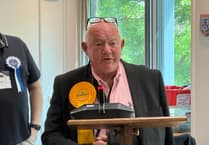ON Friday, January 22, members of Thorverton History Society enjoyed the warmth and comfort of their homes to hear Robin Blythe-Lord present a fascinating talk via Zoom on the history of Mount Batten, the promontory in Plymouth Sound that shelters the Cattewater and provides a safe harbour in the estuary of the River Plym.
Illustrated by stills and video, Robin’s talk touched on aspects of archaeological evidence and existing structures, from prehistory to the present day.
Robin illustrated evidence of prehistoric settlement and trade in tin and metal ores at Mount Batten dating from the Bronze Age, Iron Age and Roman periods. The ores coming down the Plym from adit mines on Dartmoor to the lee of "How Stert" (a high place) as it was then called.
The site progressed to be associated with fishing, trading, piracy and smuggling activities, but by the 16th century it was a recognisable defensive position, fortified against the Spanish, with an effective field of fire protecting Plymouth. A significant feature of the skyline, Mount Batten Tower is the remains of the latest circular artillery fort built out of local limestone in 1652.
By the late 19th century as the Citadel’s ordnance took over, it began to fall into disuse and extensive quarrying of limestone undermined and threatened the structure.
A petition from leading citizens saved it however, and as a Scheduled Ancient Monument, it has undergone a full refurbishment and is administered by the Mount Batten Sailing and Water Sports Centre.
Another function of Mount Batten touched upon was burial. Plague outbreaks required the City to find suitable sites for mass burial and "Pest Houses", as well as in the Civil War. By Napoleonic times, French prisoners of war were housed here and by the 19th century Cholera victims!
Despite this grim news the area was also popular in the 1800s for a bathing beach and the Castle Inn.
This fledgling tourist industry came to an abrupt end when naval shipyards took over and Mount Batten Breakwater was built which afforded additional shelter.
It was subsequently used as an air-station and to store flying boats. Sea plane trials took place at Mount Batten as early as 1913 for the RNAS and then for the RAF, and Sunderland flying boats of the Royal Australian Air Force operated from here during World War II.
At this point Robin introduced a most famous inhabitant of the air base, one Aircraftsman Shaw (Lawrence of Arabia) another fascinating story. He contributed greatly to the development and provision of fast speedboat design to assist in air sea rescue.
Reaching the present day, the breakwater has become a popular site for anglers, views of Plymouth Sound and the annual British Firework Championships and the Mount itself features the nationally renowned water sports centre opened on the site of the Castle Inn and a small residential community.
The talk was a fascinating timeline of development and strategic use of this distinctive feature of Plymouth Sound and provided much interest. Very many thanks to our excellent speaker, Robin Blythe-Lord, for a lively and well documented talk!
• The next three scheduled History Society talks as follows:
March 26 - John Allan: "St Nicholas Priory”, April 23 - Paul Rendell: “Burrator Farms - Life in a Dartmoor Valley”, May 28 - Simon Dell: “The Dartmoor Conchies”.
To register for any of these talks please email: [email protected] .
Recorded by Ann Marshall





Comments
This article has no comments yet. Be the first to leave a comment.